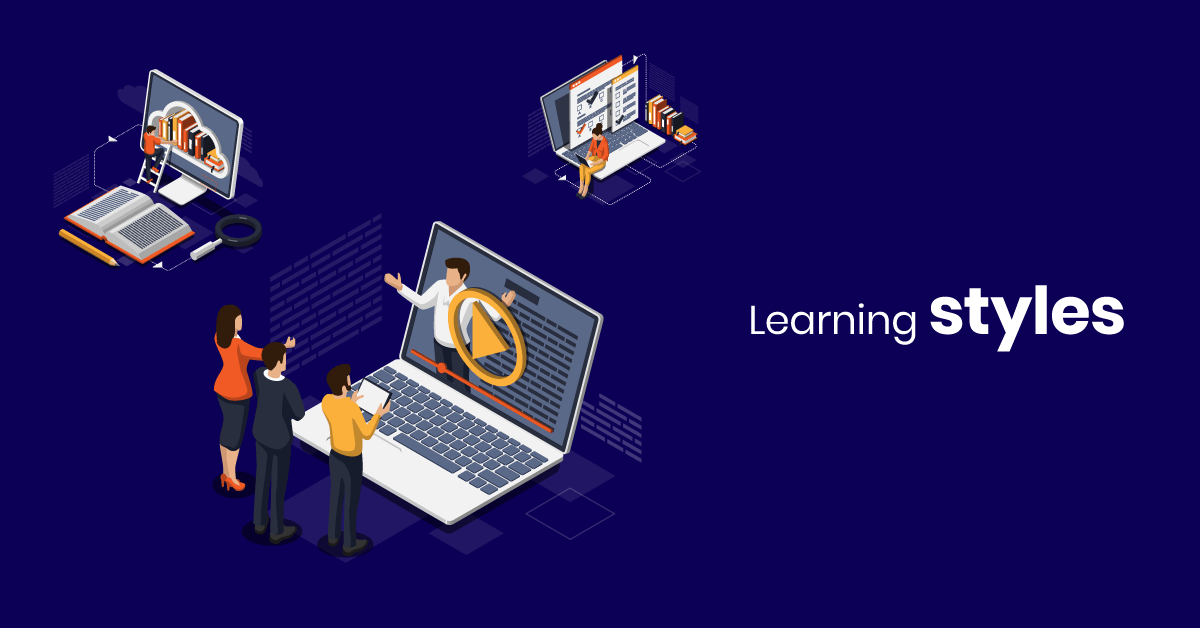You may have noticed it already in the way your employees interact with your training program: different people learn differently. Some will lose interest during long lectures, while others will shine with their interesting remarks and questions. Some will always score poorly at written tests but do great in practical simulations. And others will have no problem grasping theoretical concepts — but will struggle with practical applications.
The common thing between all these different types of learners? They all want to learn — and they deserve to learn in such a way that leverages their strengths and helps them make progress.
To accommodate different learning styles at work, you need first to know how your employees learn.
What are the different learning styles?
There has been a lot of back and forth when it comes to identifying the types of learning styles. The idea started percolating in the 1970s and, in 1987, school teacher Neil D. Fleming created the first questionnaire, VARK, to help identify learner types.
The main types of learning styles are:
- Visual learners, who learn by consuming visual content like videos.
- Auditory learners, who learn by listening (lectures, audiobooks, etc.).
- Reading learners, who need to read text in order to absorb information.
- Kinesthetic learners, who learn best by practicing and being hands-on.
Although these different learning styles can tell us a lot about how people communicate and absorb information, they are not set in stone. Learning types can evolve or change as people grow up. Also, different learning types can become more dominant in different contexts.
Still, knowing how the different ways of learning can entice or disengage learners is crucial to creating a successful employee training program.
Learning styles in the workplace: How to accommodate them
So what do each of these different types of learners need from an employee training program? And how can you best accommodate them? Here’s a breakdown based on each learning type:
Visual learners
You’ve heard it before: a picture is worth a thousand words. This couldn’t be more true for visual learners who tend to forget things they read in textbooks when there are no pictures or graphs. They will likely drone off during long Zoom webinars where not much happens.
To keep visual learners engaged, video content is key. Create microlearning sessions with videos and interesting graphs that will allow learners to grasp and retain the main points of a course. Instead of text-heavy resources, provide them with infographics (that way you can illustrate data in a more memorable way). Avoid talking head videos, though: these actually work better for auditory learners.
Auditory learners
For auditory learners, the best way to retain information is through sound. Auditory learners usually find instructor-led Zoom sessions engaging, especially if the SME doing the presentation is a confident public speaker. Nuances like a rich vocabulary, alliteration, and rhymes help them.
To accommodate auditory learners, instructor-led sessions are a no-brainer. But because scheduling instructor-led training is not always cost-effective or helpful for everyone, consider asking your SMEs to film short, talking head videos. Talking head videos give auditory learners the human voice aspect they need — plus they can watch them as many times as they need. When it comes to extra resources, consider audiobooks and podcasts.
Reading learners
Nowadays, we’ve put a lot of focus on video and audio when creating eLearning courses. And while it’s true that younger generations, i.e. millennials and Gen Z employees, like this variety in training content types, there are still those who prefer learning through reading. Reading learners often feel overwhelmed when they have to watch videos or listen to podcasts to get the information they need.
Plus, if you’re in a multinational workplace, some employees might struggle to follow a video if the instructor doesn’t speak their native language. To keep them engaged, make sure to always include the transcripts so that they can easily skim the text and focus on the key learnings. Including subtitles even in short, microlearning videos, is another great way to help reading learners. More importantly, subtitles, transcripts, and additional written resources help learners with hearing difficulties.
Kinesthetic learners
Also called “tactile learners”, kinesthetic learners struggle the most with passive learning. This type of learner needs to be bodily engaged while learning; they need to be able to create, practice, and collaborate. Kinesthetic learners do great in “learn-by-doing” environments.
To accommodate kinesthetic learners, include dialogue simulations and role-playing scenarios in your training program. Make sure to also promote collaboration by assigning them team projects to work on and by encouraging them to ask questions during instructor-led sessions.
So there you have it: catering to these four different learning styles in the workplace will ultimately help ensure the success of your employee training program.

Tips for creating an inclusive training program
Chances are, your team consists of at least some people from each learner category. Besides, each person could have — and probably has — more than one learning style. For example, the same employee could prefer to read a guide to learn about a product’s key functionality, while a video or a role-playing activity would be more suitable to understand how to use selling techniques.
Below are some tips for ensuring your training program is inclusive for a diverse workforce.
Invest in combined learning
Trying to accommodate all four different learning styles in the workplace may feel like a study in futility, but the solution is simple. The best thing you can do is use combined learning, aka combine techniques from each one of the four categories.
For example, one learning module can include one instructor-led session (recorded, with the transcript made available), microlearning videos with subtitles, infographics, reading material, simulations, and collaborative assignments. That way there’s something for everyone — and not one learner type has an unfair advantage over the other types.
Focus on learner engagement
Most likely, and especially if you’re training large teams, you don’t know each person’s learning style. One thing is for sure, though: people use their senses to engage with the training content. And the more engaged they are, the more they learn. So, make sure your training gives learners the chance to express themselves and be actively involved. You can add quizzes or short exercises that ask learners to click, drag and drop, or type. You could give them the chance to record a video or audio answer to an assignment. And you can create dedicated spaces (i.e. forums) where learners and instructors can connect and interact.
Strike a balance between self-paced and structured learning
With so many employees having to reconfigure their schedules as they work remotely due to the pandemic, flexibility matters. But so does having a structure when it comes to learning. Offering a mix of set and self-paced modules will help alleviate stress in already overworked employees and show you’re taking their personal circumstances into consideration. And whatever you do, always make sure to give learners the opportunity to retake courses and listen to the material again. Repetition and practice help knowledge stick.
Conclusion
Training is and should be for everyone, regardless of their different types of learning styles. Offering inclusive learning is not just a box you tick; it’s an integral part of your success story.
To make sure your training indeed caters to all learning styles in the workplace, you need to be able to have access to the right data and reports. The data will tell you where your employees struggle, what they learn after a training course, and how much information they retain in the long run. You also need access to the right tools to build all those elements that accommodate different learning styles — from microlearning videos to infographics and everything in between.
In other words, you need a training platform that can help you create this inclusive learning experience in the workplace.



